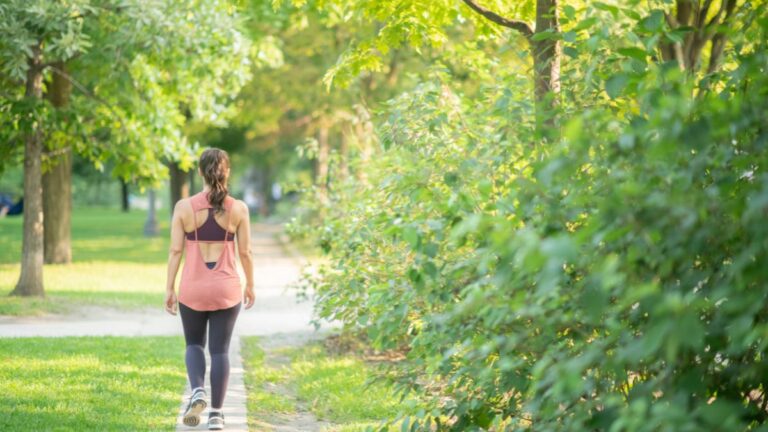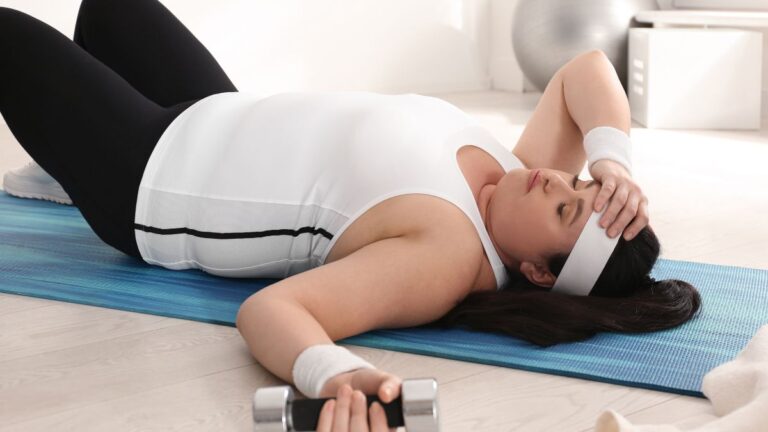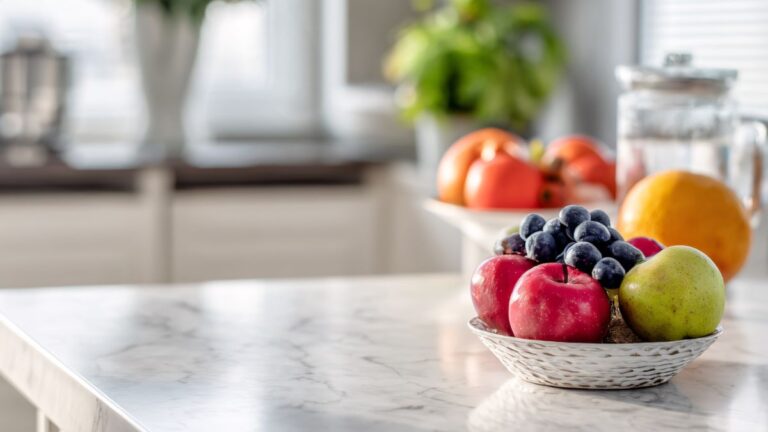Your Walking Plan for GLP-1 Strength and Sanity
Walking seems to be trending lately, but for women on GLP-1s, it’s more than a step-count challenge. It’s one of the simplest ways to help your body adjust to all the changes happening inside, like digestion, energy, and mood.
When your appetite drops and your meals get smaller, your body slows down a bit, too. Muscles don’t get as much work, and your metabolism, the system that powers everything you do, can get a little quieter.
Walking helps keep things moving, literally. It supports digestion, steadies blood flow, and reminds your muscles they still have a job to do.
It’s not about burning calories or earning steps. It’s about giving your body a steady rhythm again, so strength training, recovery, and daily life all feel easier.
Why Walking Hits Differently On GLP-1s
Your medication slows down digestion and appetite. That’s what helps steady your blood sugar and reduce hunger, but it also changes how your body moves and recovers. With less food coming in, there’s less energy being created, and that can make your body feel slower overall.
Walking helps wake things back up. It keeps your blood flowing, muscles active, and digestion working smoothly.
Every step does something your medication can’t:
- Moves nutrients through your system. Walking helps food move along, so you feel less bloated or sluggish after meals.
- Reactivates your core and glutes. These muscles play a big role in how you stand, digest, and stay balanced. They can weaken during rapid body changes, and walking helps keep them engaged.
- Boosts oxygen delivery. The cells in your body use oxygen to burn fat and repair muscle tissue. Even a short walk helps that process run better.
- Calms your nervous system. When hunger signals quiet, you may also lose the emotional rhythm that eating once gave you. Walking helps replace that rhythm, a grounding cue that reminds your body what steady feels like.
Walking isn’t just cardio. It’s how you help your body stay active, balanced, and connected while everything else is adjusting; it’s physiological maintenance.
The Walking–Strength Connection
Walking and strength training work best when you combine them. Strength training builds muscle, and walking keeps it active between sessions. The two are partners, not competitors.
Here’s how they work together:
- Circulation and recovery: Light movement after training helps clear out metabolic waste so your muscles can repair faster and feel less sore.
- Metabolic signaling: After you train, your muscles become more sensitive to insulin, which helps your body use nutrients better. Walking in the 24 hours after training keeps that process going.
- Hormonal balance: Regular walking can help lower cortisol, the stress hormone that breaks down muscle when calories are low.
- Mind-body feedback: Training develops awareness; walking reinforces it. The more you move, the more your body learns what “engaged” feels like.
If you train two or three days a week, use walking on the other days as active recovery. It keeps your body in motion, supports your training, and helps everything work together instead of in separate parts.
Beyond Steps: What Walking Really Changes
Most people focus on hitting a certain number of steps, but you’ll get more out of noticing how your body responds. Walking helps your body work better from the inside out.
- Digestion and gut rhythm – GLP-1s slow how quickly food leaves your stomach, which can sometimes cause bloating or constipation. A short 10-minute walk after meals helps your stomach and intestines contract naturally so food moves through more smoothly. Over time, your digestion starts to find a rhythm that matches your medication pace.
- Mental health and nervous system – These medications do more than calm the appetite. They can also shift how your brain uses dopamine and serotonin, which can affect mood and motivation. Walking helps restore those brain chemicals in a natural way. It’s less about chasing endorphins and more about helping your brain and body feel balanced again.
- Muscle preservation – When weight comes off quickly, your body can lose some muscle, too. Walking keeps smaller stabilizing muscles, especially through your core, hips, and legs, active and strong. Paired with strength training, it helps you maintain the muscle that keeps your metabolism flexible and your posture steady.
- Circulation and lymphatic flow – Fluid retention and swelling can increase when your body composition changes quickly. Walking helps your lymphatic system move waste products and reduces that puffy, inflamed feeling.
- Breathing and posture – Most of us forget to breathe fully when we sit all day. Walking re-teaches diaphragmatic breathing, expanding the ribs, releasing tension in the back, and improving oxygen flow. Better breathing means better recovery, digestion, and stress management.
Your Seasonal Strategy
How you walk in July shouldn’t look the same as how you walk in January. Different seasons call for different strategies, especially when you’re trying to stay consistent year-round.
Northeast Winter
Cold weather makes muscles tighten and motivation drop, so focus on keeping movement small and steady.
- Break your walks into short bursts, about 5 to 10 minutes, two or three times a day.
- Layer up and walk briskly to generate heat, even if you stay close to home.
- If it’s icy, walk laps inside your home or at a store. Think of these as “circulation snacks.”
- Pair walking with strength or mobility drills indoors, like heel raises, wall sits, or seated marches.
Southern Summer
Heat and humidity raise heart rate and drain electrolytes, making even short walks feel tough.
- Walk early in the morning or later in the evening when it’s cooler (pick shaded areas if possible).
- Bring water every time, even for short walks. GLP-1s can blunt thirst, so drink before you feel it.
- Split longer walks into shorter 10-minute segments throughout the day.
- On extreme heat days, switch things up with pool steps or gentle movement inside where it’s cool.

Fall and Spring Reset
These seasons are perfect for variety.
- Add hills or soft terrain to challenge your glutes and hamstrings.
- Take advantage of the balanced temperatures to walk a little longer, around 30 to 45 minutes.
- Notice how your breathing feels different outdoors; use it as feedback for your training days.
The Plan (And Why It Works)
Forget 10,000 steps. What matters most is having a plan with purpose and a pattern you can stick to.
Level 1: Activation
Start small with short, frequent walks, about 10 minutes after lunch or dinner. Focus on how you move: keep your ribs lifted, glutes active, and arms swinging naturally. These mini walks wake up your metabolism and help food move through your system.
Level 2: Integration
Add one planned walk that lasts 20 to 30 minutes, three or four times a week. Use this time to reset mentally. Listen to a podcast, your favorite playlist, or enjoy some quiet time. Make it something that feels restorative, not like a chore.
Level 3: Extension
Once you have a rhythm, start pairing your walks with strength training days. Walk before your session as a warm-up or after as a cooldown. On non-training days, take longer or more scenic routes to keep walking enjoyable and fresh.
The goal: build awareness around movement and how it connects to your medication, digestion, and mood. The more consistent you are, the more your body learns what balanced movement feels like.
Walking, Eating, and Finding the Right Rhythm
Walking and eating may not seem connected, but on GLP-1s, they work hand in hand. The medication changes how your body digests food, how hungry you feel, and even how your brain interprets satisfaction. Pairing regular walking with balanced meals helps those systems talk to each other again.
How walking helps your body use food better:
- Protein works harder for you. When you walk after eating, blood flow to your muscles improves, which helps your body use amino acids for repair and recovery.
- Fullness feels clearer. Post-meal walking stabilizes glucose, reducing “sugar crashes” that can confuse hunger cues.
- Constipation eases. Gentle movement supports peristalsis, the wave-like contractions that keep your gut regular.
- Hydration gets absorbed. Circulation helps your cells retain water and electrolytes more effectively, which matters when you’re not drinking enough.
How To Eat in A Way Your Body Can Handle
Because GLP-1s slow digestion, many women eat less than they need. Some are afraid to eat at all because of how quickly fullness hits or from fear of gaining weight back. But eating too little for too long can actually make your metabolism slow down.
Try to reframe how you think about food:
- Focus on minimums, not restrictions. Eat enough to keep your energy steady and your muscles fed.
- Listen to your body’s pace. Fullness is feedback. Aim for comfortable (about a 4-5 on the hunger scale), not stuffed or starving.
- Stay consistent. Skipping meals or severely under-eating can make your body hold onto energy, which slows progress.
- Check before adjusting your dose. If weight loss has stalled, it’s not always about needing more medication. Sometimes it’s about nutrition, hydration, movement, or recovery.
- Use smaller, balanced meals. If large meals feel uncomfortable, break your day into smaller ones with protein, fiber, and water.
Walking supports every part of this process. It helps food move through your system, keeps your muscles active, and brings calm back to your nervous system so you can read your body’s signals better.
Mindset: When Walking Stops Being “Just Walking”
One of the biggest mindset traps on GLP-1s is thinking movement has to be intense to count or believing you don’t need to move at all since the medication is helping. Both extremes can backfire. Intensity isn’t the same as impact, and being sedentary can make it harder for your body to stay healthy long-term.
The women who keep their results aren’t the ones who push to exhaustion or sit still and wait for the medication to do the work. They’re the ones who build habits that work together, walking that supports digestion, training that keeps muscle strong, and routines that bring calm instead of stress.
Walking is where those habits meet. It’s the reset that clears mental clutter and helps you feel connected to your body again.
When you make walking a regular part of your week, you start to notice subtle changes:
- Meals digest more comfortably.
- You crave water instead of forgetting it.
- Recovery between training days feels smoother.
- Stress doesn’t stick as easily.
- You actually want to move more.
Your body remembers what balance feels like, and walking helps it find that rhythm faster.
Sample rhythm: 2-Day Strength Focus
- Sun: Rest or light mobility
- Mon: 20-min walk after dinner
- Tue: Strength session and 5-min cooldown walk
- Wed: 30-min “sanity” walk outdoors (weather permitting)
- Thu: Strength session and digestion walk after lunch
- Fri: Active recovery (stretching and 15-min walk)
- Sat: Longer, social walk with a friend or podcast
Busy week alternative: Commit to 10 minutes daily, same time, same place.
Consistency builds momentum faster than intensity ever will.
Bonus: An Indoor Option That Actually Works
If going outside or finding time to walk feels impossible, a walking pad or under-desk treadmill can be a great tool to keep your body moving. You can walk while working, watching TV, or listening to music without needing to schedule it.
It’s a fantastic option because:
- You don’t have to leave the house. Try short 5–10-minute walks on the pad after meals to help digestion.
- It keeps your circulation, digestion, and mindset steady even on busy or cold days.
- Most walking pads are small, easy to store, and more affordable than people think.
- Use them in short bursts, keeping your posture upright and your stride natural.
The goal is to keep your body functioning at its best, no matter the season or your schedule.
What Matters Most
Walking doesn’t replace training. It enhances it.
It supports digestion, steadies your mood, preserves your muscle, and keeps your metabolism active when calories are lower. It helps your body adjust to medication, movement, and life all at once.
Start small. Add purpose. Stay curious. Notice how your body feels before, during, and after each walk. Over time, that awareness becomes your best progress tracker. Every walk is communication between you and your body.
Photo Credits
Walking in the park by Fat Camera from Getty Images Signature
Spring, summer, fall, winter signpost from Getty Images
This article is for educational purposes and is not intended to replace medical consultation. Always consult a healthcare professional before making health-related decisions.
Most programs teach exercise.
The Remedy Method retrains how your body communicates: how your brain, muscles, and movement work together again after change.
It blends corrective exercise, Pilates control, and progressive strength in a way that helps your body relearn balance, rebuild strength, and move with confidence again.
If your body feels different and you’re not sure where to start, this is the method designed for exactly that.





